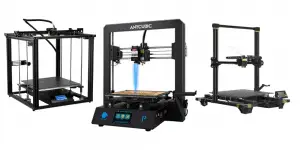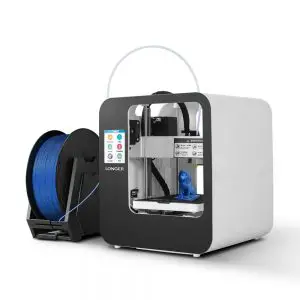The Epax X1 3D printer, a resin printer, is certainly unlike any printer you’ve used before that uses filament. Resin printers use a liquid polymer, rather than a twine-like filament, to add layers and print an object on the build platform. Rather than melting like filament, the liquid becomes a solid when hit by a UV laser. This process is called stereolithography, and versions of it were in use long before the first commercial 3D printer appeared in 2009. Today we will be taking a close look at the at the Epax X1 resin 3D printer. This is a mid-range stereolithographic printer that boasts efficient operation and nearly flawless print quality.
Epax X1 3D printer Technical Specifications
- Max Print Size: 115 x 65 x 155 mm (LxWxH)
- Resin Type: Both FEP and non-FEP film; most 405NM LCD resins will work
- Print Speed: Epax recommends 20 mm per hour
- Power Rating: 50 watts
- X/Y Resolution: 47 microns
- Z-Axis: 0.01 mm
- Print Time: about 6-7 seconds per layer
- Operating System: ChiTu Box
Design and Features of the Epax X1
The Epax X1 3D printer uses LCD technology. The UV light that solidifies the resin comes from a bank of LEDs filtered through an LCD screen. The 2560 x 1440 pixel resolution of the LCD screen is what gives the 47 micron X/Y resolution. This is what you’d expect from any 3D resin printer costing less than $1,000. It’s a good universal resolution, able to add detail with its separate layers. You sometimes find resin printers with as low as 10-micron resolution. Despite what manufacturers would have you believe, more microns/higher resolution do not automatically mean a better-finished product.
Aesthetically, there isn’t much decoration to the Epax X1 3D printer. It’s built for efficiency, with the plastic and metal shell protecting the delicate screen and LED array inside. It is a long black rectangle, with the print area accessible behind a white door that has a single handle on bottom. Though it’s low-cost enough for hobbyist and non-commercial makers, this is an industrial-style printer with an efficient design to reflect its singleness of purpose.
Features include a vat capable of handling non-FEP film. Epax says the non-FEP film it provides is superior to other resins and suited to the X1. Many makers prefer the non-FEP film, because it won’t stick to the screen when you go to retrieve your printed object. Rubber infused in the film, too, makes it leakproof although we’re skeptical about how perfect the leak proofing is. A 3.5-inch full-color touchscreen gives you access to a rich menu. It will take some learning, but the settings and other functions are intuitive and you won’t have any problems navigating them.
The printer has a 50 watt light source, stepped down to 40 watts to preserve the LCD screen and give it a longer life. The design is a bit of a space saver because you can place the X1 flat in front of a wall and always access your prints by opening the front door. The door is big enough to get in and maintain or change parts on the printer easily, should the need arise. The cover lifts up, not off to the side, keeping it out of the way and also letting you place the printer in a corner where two walls meet, to save even more space in your studio.
Epax X1 Printing Quality
One nice thing about the Epax X1 is that it ships ready to print. Settings are programmed at the factory, and the box contains all the hardware and tools you need to make your first build. We’ll break down the box contents in the next section.
All that prep work on Epax’s end makes for a stable and consistent printing experience, even if you aren’t used to UV resin printers.
If you are used to using filament printers with extruders, loading the resin will be a new experience for you. It pours into a vat which is then heated by the UV to form the solid layers for your object. It’s a longer process than extruder printing, but also gives you more precise control and greater detail because of the thinner layers versus filament extrusion. The Epax X1 gives you printed objects with smooth surfaces and great detail, even for small pieces that form part of a larger object. The printer lets you experiment with different resins, too, to get varying degrees of surface smoothness.
Here’s an example, if you are still wondering what a printer like the Epax can do and why you’d want to spend the extra money versus a similar extruder model.
Imagine you want to make a Crocs-style slip-on clog for general wear. The footbed needs to be textured, to help you grip, but the textures have to be smooth. If they are even a bit rough, the ridges will cause discomfort and you won’t be able to wear the shoes for long.
Because an extruder printer uses fewer layers, the footbed will have irregularities that will interfere with comfort. They may be barely noticeable, but you could feel them if you put an extruder clog on one foot and a UV-printed one on the other. The one made with UV and resin will be more comfortable, and the texturing will hold your foot in place while yielding to pressure. That’s because the UV printer uses more layers, and the layers are thinner to prevent noticeable protrusions. This also means UV printer objects are easier to clean and disinfect because there are not as many microscopic ridges and gaps for germs to hide in.
We said all that to say that the print quality of the Epax X1 resin 3D printer is of a quality you can count on. If you want to make those finely detailed parts say for a plastic model kit with dozens of tiny engine parts on a snap-off frame, the X1 is one of your best intersections between consistent quality and an affordable price. On top of that, you can experiment with different types of resin to see what gives you the right feel and texture. Just make sure to wear gloves any time you handle liquid resin, and read the warnings on the bottle, too. You may need a breathing mask and extra ventilation for certain liquid resins.
Packing and Assembly
Epax ships the X1 UV LCD 3D printer with everything you need in the box–except for resin. Because of its volatile nature, shipping liquid resin is tricky. That’s especially true if ordering from overseas, as resin can’t ship by air in some countries. This doesn’t sound like a deal-breaker to us, but you should be prepared if you’re used to extruder printers. Those models typically come with a starter pack of filament.
Just like the build plate on an extruder printer, the Epax X1 uses tape on the print surface. There are specific directions for installing the tape and keeping it in place. You’ll want to follow them exactly to prevent warping of the plate or a misshapen or stuck final product. You will also have to install the slicing software by plugging in the included USB drive and following the prompts
What Comes With The Epax X1 3D printer?
- Epax X1 Printer
- 1x USB stick loaded with a manual PDF file, a sample print file, and a ChiTuBox config file.
- Build platform (there are directions for installing this before first use)
- Instructional videos (watch these even if you have used a resin printer before)
- 1x extra non-FEP film
- 1x power adapter
- 1x shovel
- 2x resin filters
*No resin is included in the box.*
After the first print, whether the test object or your own creation, you have to wait until no more resin drips from the build platform. Then you can take the whole platform off. Use the included hand shovel (it’s plastic) to gently scrape the build object off the plate. Soak the object in IPA (also not included in the box). This cleans off any excess resin and prevents further chemical reactions. After soaking, you can place the creation in a cool, dry area with air circulation. It takes a few hours for the object to dry before you can paint or put to use.
Epax Support
When we messaged Epax for questions about this article, the agent was quite polite and responsive. We get the idea that the company is a startup and perhaps understaffed. The company’s U.S. headquarters are in North Carolina–at least, we think it is. It’s hard to tell. The company is growing and, at the time of this writing, was looking for partners for international distribution.
If you need support, or if something goes wrong with your printer, you have a website, phone number, email, and FaceBook page. Customers are a small but loyal group, and you can even find Epax and printer-specific Reddit pages and FaceBook groups. We don’t think you will get the runaround; the agent we spoke with answered our questions right away and seemed enthusiastic. But we can’t vouch for how difficult it would be to get warranty repairs or service. Even the owner’s manual does not say whether you have to ship the malfunctioning printer back or not.
If you are good with self-instruction and video learning, there is a company Epax page with setup directions, troubleshooting procedures, potential projects, and more for you to peruse and enjoy.
Epax X1 Resin 3D printer Pros and Cons
Epax X1 PROS
- Clamshell lid is easy to open, stays out of the way for build retrieval
- Design is solid, industrial aesthetic with flat edges and protected inner workings
- Maintenance is easy due to the large working area and ease of access
- Epax will sell you non-FEP film, which sticks to the screen less than FEP and won’t damage your build
- Anti-aliasing mode: automatically adjusts stray pixels and low res; makes your build look injection molded
- Set-up is fast and easy, mostly automated or preset so you can start creating right away
- Epax generally has a good reputation for customer service
Epax X1 CONS
- Warranties are shorter than the industry standard
- For beginners, using the liquid resin is more difficult and settings are more challenging than an extruder type
- Comes with a USB drive, but no Micro SD card
The Verdict
We don’t recommend the Epax X1 UV LCD resin 3D printer for a bare-bones beginner, or for a classroom where kids will be learning to 3D print. The resin is potentially toxic and always requires personal protective equipment. Use of it, and figuring out the deeper settings, requires training and close supervision by an expert.
But if you are an expert, and you’d like to up the quality of your builds for your business or artistic endeavor, this is the resin printer for you. The price is low enough that you don’t have to feel bad if you buy it and find you don’t like it. Settings and calibration are done for you, but you can quickly learn to tweak everything the way you want it. Customers who buy the X1 are loyal enough to have their own active Reddit groups. Epax is professional, and responsive to help requests. Removing your build, a tricky proposition for any compact printer is easy with the clamshell lid and wide open cavity. Assembly is easy, with the manual providing photos and written directions. For the money Epax wants, we say you won’t find another 3D printer that will deliver the superior results of the Epax X1 resin 3D printer.
Last update on 2024-05-13 / Affiliate links / Images from Amazon Product Advertising API





